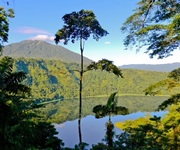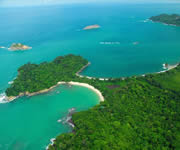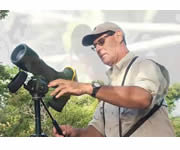- The initiative aims to encourage Costa Ricans and visitors to discover the riches of the region: rivers, waterfalls and lakes along with flora and fauna and the hospitality of its inhabitants.
- “This is a historic day for the municipality of Río Cuarto. We have been working tirelessly to promote the name of Río Cuarto around the country and the world,” said the mayor, José Miguel Jiménez.
- The virtual inauguration ceremony, which was attended by the President of the Republic and the Minister of Tourism, featured the first rendition of the anthem of the canton, the youngest in Costa Rica.
Thursday, May 20, 2021 - The new canton brand “Río Cuarto, todo por descubrir” (Río Cuarto, everything to discover) was launched on Thursday in a ceremony held in the town’s community center, which was virtually attended by the President of the Republic, Carlos Alvarado Quesada, and the Minister of Tourism, Gustavo Segura Sancho.
Held at the same time as the celebration of the fourth anniversary of the creation of Costa Rica’s youngest canton, the launch ceremony featured promotional videos that showcased the canton’s tourist attractions and the values of its inhabitants. These videos, along with the canton brand, are part of an effort by Río Cuarto to establish itself as a destination for Costa Ricans and visitors to the country from abroad.
“For the municipality and Río Cuarto, the launch of the canton brand is a historic event,” said José Miguel Jiménez, the canton’s mayor. “We have been working with high hopes, always striving for excellence in order to promote the name of Río Cuarto around the country and the world. We hope that people know where we are and come to see the wonders we have to offer, our beautiful waterfalls, lakes, flora and fauna. In Río Cuarto, there is everything to discover.”
President Alvarado congratulated Río Cuarto for their anniversary, noting that the launch of the canton brand is a cause for celebration.
“When you explore the paths of Costa Rica, you find regions of incredible scenic richness that make you wonder why no one ever told you that they were there,” remarked Alvarado. “It is because we know the incredible beauty and potential that Río Cuarto has to offer that we want to promote Río Cuarto, we want the country’s youngest canton to welcome more tourists who will explore its tourist attractions, meet its people and come back as often as they wish.”
In a video, Minister Segura noted that Río Cuarto’s rivers, waterfalls and lakes, among other attractions, made it one of the many options that our country offers to domestic and foreign tourists. “The Costa Rican Tourism Board congratulates the residents of Río Cuarto for the launch of their canton brand, a demonstration of the essence of Costa Rica. To those who have not yet gotten to know the region, we invite you to make a visit while following public health protocols.”
Prior to the launch of the canton brand “Río Cuarto, everything to discover”, the Executive President of the Rural Development Institute (Inder), Harys Regidor, and the General Manager of COOPELESCA, Omar Miranda, signed an agreement that would provide Internet access to nearly 5,200 inhabitants of the region.
Community anthem. The enthusiasm surrounding the canton’s anniversary also saw the composition and first rendition of the canton’s anthem by the tenor Gustavo Acosta Rojas in Thursday’s ceremony.
Following a contest held by the local government, the entry entitled Himno a Río Cuarto (Anthem of Río Cuarto) by local musician Erick Mora Marín, age 32, was selected. The song pays tribute to the canton’s three districts and its lyrics emphasize the importance of water.
In October 2020, Mora Marín was inspired to create the anthem during a visit to various attractions in the canton. An additional note of interest is that the musician’s wife, Lady Chávez, added some of the lines at the end to reinforce the sense of belonging of the inhabitants of Río Cuarto.
How did the Río Cuarto canton brand come to be? Río Cuarto is the 82nd canton of the country, and was formed in 2017 when it officially split from the canton of Grecia.
Currently, the canton is seeking to encourage visits from Costa Rican and international travelers, calling on them to explore the sights of the region, which include rivers, lakes and waterfalls such as Poza La Flor, Casa de Las Lapas, Río Cuarto Lake, Bosque Alegre Wildlife Refuge, Lagunas del Hule, Paraíso de Manantiales, Pozo Azul Waterfall and the Río Toro Canyon.
The community is inviting tourists to discover its attractions as well as the warmth, spirit of service and generosity of its inhabitants, while fully respecting the public health protocols in place to stop the spread of COVID-19 at all times.
From the beginning of his mandate in May 2020, Mayor José Miguel Jimenez proposed the creation of the Río Cuarto canton brand as a strategy to raise the profile of the region for tourists from Costa Rica and abroad.
These efforts included interviews with local pioneers, community leaders, development associations, business leaders, religious organizations and leading citizens from the canton. The responses from participants were used to select the key recurring terms to build a concept of Río Cuarto’s idiosyncrasy.
Río Cuarto is seeking to be perceived as an environmentally conscious region that offers enjoyment and relaxation, an ideal destination for family or group travel. The Mayor emphasized that the canton is committed to protecting the environment and offers excellent potential for investment in areas such as tourism, industry and services.
As part of the launch of the canton brand, the Río Cuarto official social media pages and website were also put online. Those interested can find more information on the canton’s Facebook profile and the website of the Municipality of Río Cuarto: www.muniriocuarto.go.cr









